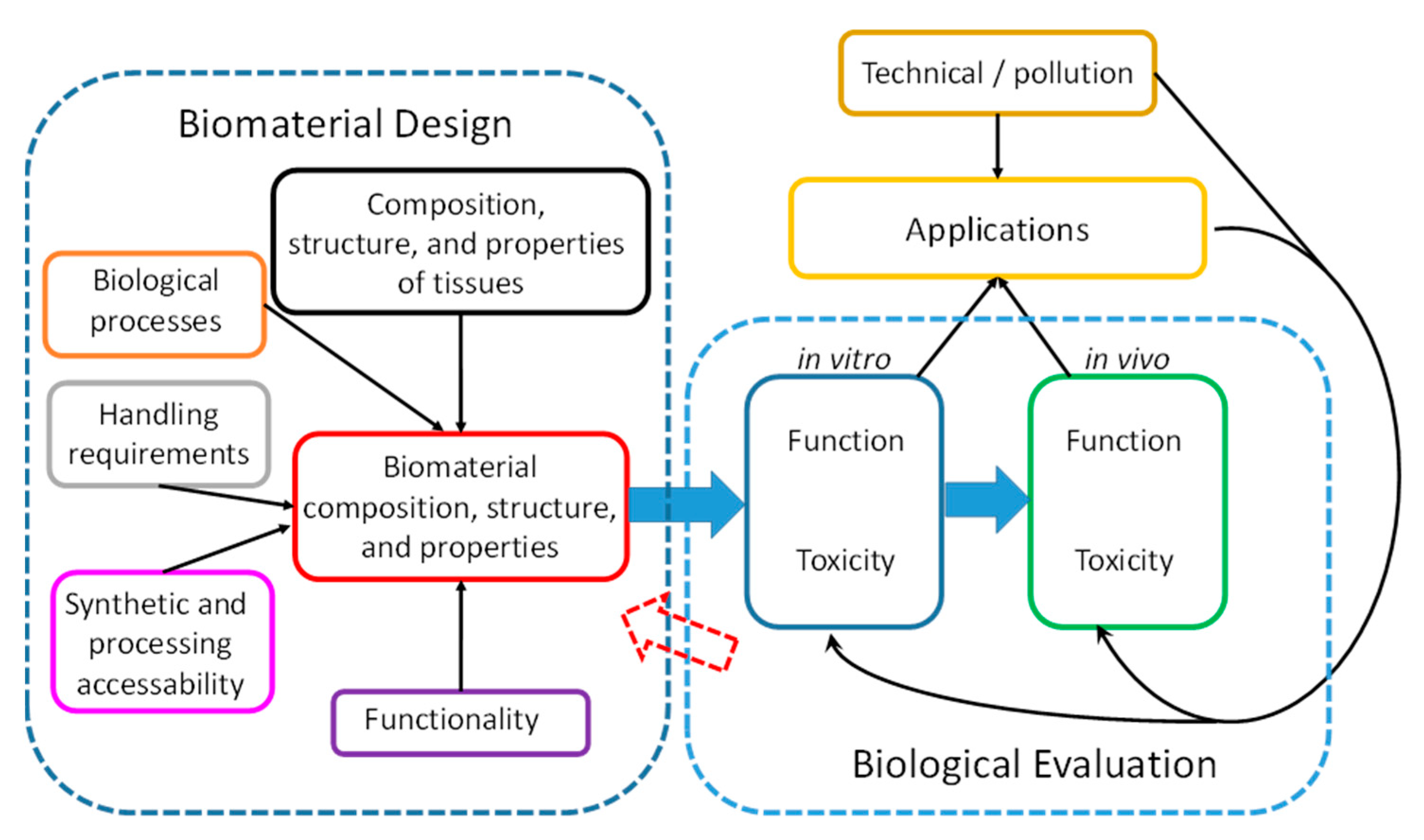Cell–Material Interactions 2022
Conflicts of Interest
References
- Tung, W.T.; Maring, J.A.; Xu, X.; Liu, Y.; Becker, M.; Somesh, D.B.; Klose, K.; Wang, W.; Sun, X.; Ullah, I.; et al. In Vivo Performance of a Cell and Factor Free Multifunctional Fiber Mesh Modulating Postinfarct Myocardial Remodeling. Adv. Funct. Mater. 2022, 32, 2110179. [Google Scholar] [CrossRef]
- Williams, D.F. There is no such thing as a biocompatible material. Biomaterials 2014, 35, 10009–10014. [Google Scholar] [CrossRef] [PubMed]
- Uzieliene, I.; Bironaite, D.; Bagdonas, E.; Pachaleva, J.; Sobolev, A.; Tsai, W.-B.; Kvederas, G.; Bernotiene, E. The Effects of Mechanical Load on Chondrogenic Responses of Bone Marrow Mesenchymal Stem Cells and Chondrocytes Encapsulated in Chondroitin Sulfate-Based Hydrogel. Int. J. Mol. Sci. 2023, 24, 2915. [Google Scholar] [CrossRef] [PubMed]
- Le Bao, C.; Waller, H.; Dellaquila, A.; Peters, D.; Lakey, J.; Chaubet, F.; Simon-Yarza, T. Spatial-Controlled Coating of Pro-Angiogenic Proteins on 3D Porous Hydrogels Guides Endothelial Cell Behavior. Int. J. Mol. Sci. 2022, 23, 14604. [Google Scholar] [CrossRef] [PubMed]
- Munawar, M.A.; Schubert, D.W. Thermal-Induced Percolation Phenomena and Elasticity of Highly Oriented Electrospun Conductive Nanofibrous Biocomposites for Tissue Engineering. Int. J. Mol. Sci. 2022, 23, 8451. [Google Scholar] [CrossRef] [PubMed]
- Rai, P.; Robinson, L.; Davies, H.A.; Akhtar, R.; Field, M.; Madine, J. Is There Enough Evidence to Support the Role of Glycosaminoglycans and Proteoglycans in Thoracic Aortic Aneurysm and Dissection?—A Systematic Review. Int. J. Mol. Sci. 2022, 23, 9200. [Google Scholar] [CrossRef] [PubMed]
- Tomonaga, T.; Nishida, C.; Izumi, H.; Kawai, N.; Wang, K.-Y.; Higashi, H.; Takeshita, J.-I.; Ono, R.; Sumiya, K.; Fujii, S.; et al. Crosslinked Structure of Polyacrylic Acid Affects Pulmonary Fibrogenicity in Rats. Int. J. Mol. Sci. 2022, 23, 13870. [Google Scholar] [CrossRef] [PubMed]
- Nishida, C.; Izumi, H.; Tomonaga, T.; Wang, K.-Y.; Higashi, H.; Takeshita, J.-I.; Ono, R.; Sumiya, K.; Fujii, S.; Hata, Y.; et al. Effect of Different Molecular Weights of Polyacrylic Acid on Rat Lung Following Intratracheal Instillation. Int. J. Mol. Sci. 2022, 23, 10345. [Google Scholar] [CrossRef] [PubMed]
- Szmeja, S.; Gubica, T.; Ostrowski, A.; Zalewska, A.; Szeleszczuk, Ł.; Zawada, K.; Zielińska-Pisklak, M.; Skowronek, K.; Wiweger, M. Caffeine-Cyclodextrin Complexes as Solids: Synthesis, Biological and Physicochemical Characterization. Int. J. Mol. Sci. 2021, 22, 4191. [Google Scholar] [CrossRef] [PubMed]
- Le, N.; Zhang, M.; Kim, K. Quantum Dots and Their Interaction with Biological Systems. Int. J. Mol. Sci. 2022, 23, 10763. [Google Scholar] [CrossRef] [PubMed]
- Ji, G.; Tian, J.; Xing, F.; Feng, Y. Optical Biosensor Based on Graphene and Its Derivatives for Detecting Biomolecules. Int. J. Mol. Sci. 2022, 23, 10838. [Google Scholar] [CrossRef] [PubMed]

Disclaimer/Publisher’s Note: The statements, opinions and data contained in all publications are solely those of the individual author(s) and contributor(s) and not of MDPI and/or the editor(s). MDPI and/or the editor(s) disclaim responsibility for any injury to people or property resulting from any ideas, methods, instructions or products referred to in the content. |
© 2023 by the author. Licensee MDPI, Basel, Switzerland. This article is an open access article distributed under the terms and conditions of the Creative Commons Attribution (CC BY) license (https://creativecommons.org/licenses/by/4.0/).
Share and Cite
Neffe, A.T. Cell–Material Interactions 2022. Int. J. Mol. Sci. 2023, 24, 6057. https://doi.org/10.3390/ijms24076057
Neffe AT. Cell–Material Interactions 2022. International Journal of Molecular Sciences. 2023; 24(7):6057. https://doi.org/10.3390/ijms24076057
Chicago/Turabian StyleNeffe, Axel T. 2023. "Cell–Material Interactions 2022" International Journal of Molecular Sciences 24, no. 7: 6057. https://doi.org/10.3390/ijms24076057
APA StyleNeffe, A. T. (2023). Cell–Material Interactions 2022. International Journal of Molecular Sciences, 24(7), 6057. https://doi.org/10.3390/ijms24076057




